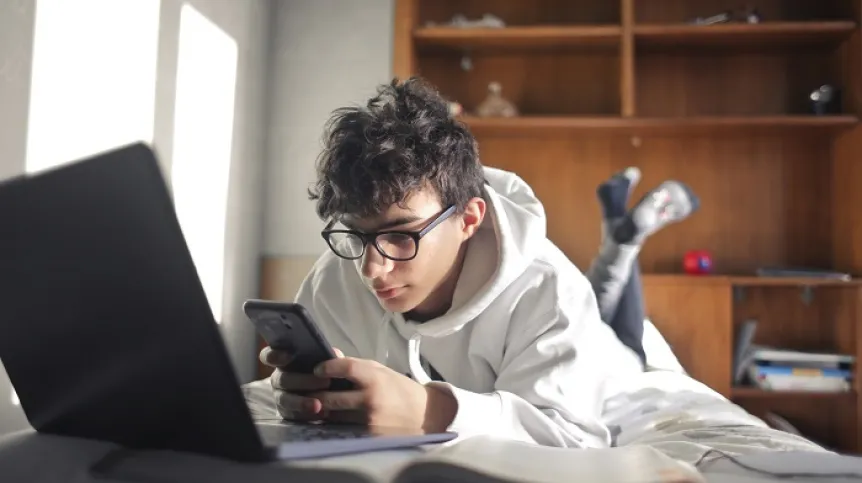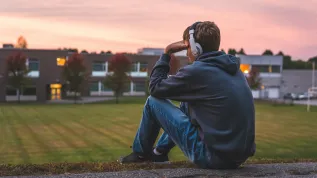
During the pandemic, young people spent an average of over 16 hours a week using social media, over 14 hours watching movies and TV series, and nearly 8 hours playing games, researchers from Poland and the Netherlands say. They warn that young people are affected not only by the amount of screen time, but also the viewed content.
A team of scientists and students from the SWPS University of Social Sciences and Humanities in Poland, Vrije Universiteit Amsterdam (VU) and Universiteit Van Amsterdam (UVA) in the Netherlands examined the relationship between the use of the media and its pro-social and anti-social content - and mental well-being of over 400 adolescents. The study was conducted in 2020 and 2021. The results were presented in May during the webinar 'Media, adolescents and well-being', organized by the SWPS University.
Why the media and adolescents?
Media psychologist from Vrije Universiteit in Amsterdam and the University of Amsterdam and the study co-author Ewa Międzyobrodzka emphasized the importance of adolescence. She said: “This is a particularly sensitive developmental period, during which the use of the media by young people can be associated with both opportunities and threats."
She added that the media can affect young people in different ways, depending on gender, age and context. Międzobrodzka cited the study published in March in Nature Communicationsby researchers from the UK. It showed that when it comes to life satisfaction, girls aged 12-13, boys aged 14-15 and both boys and girls around the age of 19 can be particularly sensitive to the effects of social media.
Parents, ask and watch what children are doing in the world of new media
The sensitivity of teenagers to the effects of using the media can be associated with brain development and individual differences in their personality.
Międzyobrodzka said: “The brain during adolescence is particularly sensitive to awards provided by +likes+ in social media and other positive reinforcements in games. Depending on the context, this sensitivity of adolescents can bring opportunities and threats.
“On the one hand, positive feedback can help young people learn more quickly (for example, how to solve a given problem in the game). On the other hand, this sensitivity can pose a risk of addiction.”
Dr. Jacek Buczny, co-author of the study, personality psychologist and self-regulation of behaviour expert from Vrije Universiteit Amsterdam and SWPS added: “There are certain personality patterns that determine the predisposition to addiction. Some people may be most exposed to possible negative effects of using the media."
Media, adolescents and well-being
The adolescents who participated in the study assessed that they spent more time using social media, games and films on weekends than during the week. The respondents declared that they spent an average of 16 hours a week on social media.
But the frequency of using the media was the not main subject of the study. The researchers were particularly interested in the content adolescents viewed during the pandemic and the relationship it could have with the well-being of young people. Researchers focused on two types of messages: pro-social (showing mutual help and empathy) and anti-social (showing violence, theft, lying).
It turned out that the study participants were more often exposed to pro-social content than to anti-social content. However, anti-social content was more important for their well-being during the pandemic.
When children go out, the parents usually ask where, with whom they will meet, what time they will get back. A child sitting in front of a computer or mobile phone does not mean it's safe. Physically - yes, but there is a mental exposure to risk due to access to all types of content.
According to the researchers' observations, in the case of high school students more frequent use of anti-social media was associated with lower general satisfaction with life and satisfaction with functioning at school, lower sleep quality and delayed time of falling asleep, said Małgorzata Biesiadecka, co-author of the study from the Psychology Students' Research Club at SWPS University. Frequent exposure to anti-social content is also associated with self-control problems, which can be manifested by a lower level of achieving goals and less effective use of time.
On the other hand, frequent use of pro-social media correlated positively with the assessment of the quality of relationships with friends: the more frequent the contact with positive content, the better the relationships based on helping and having fun. Young people used social media to keep in touch with friends, which was particularly important in the context of lockdown, when the study was conducted.
The research results presented during the webinar on the subject of media and adolescents were commented on by two experts: Dr. Łukasz D. Kaczmarek, a professor at the Adam Mickiewicz University, and head of the Positive Gaming & Streaming Psychophysiology Lab, and Dr. Konrad Maj, a social psychologist at the SWPS University of Social Sciences and Humanities, initiator and head of the HumanTech Innovation Centre.
According to Dr. Kaczmarek, these results are consistent with the general 'effect of negativity' that can be observed in the functioning of humans: negative content has a stronger effect than positive content.
Dr. Maj noted that the fact that we are exposed to anti-social content on social media may remain beyond our control. 'If you are somehow categorized by an algorithm, you can fall into the trap of anti-social content', he said.
During the webinar, experts discussed how to use the media responsibly and talked about the 'replacement hypothesis'. Dr. Maj said: “If a person spends 16 hours a week on social media, they does not do many other things that they could do, for example sports, meet with friends, etc. We must take into account that this is a cost that you cannot see. So what if people do not suffer? Maybe they don't gain something that they could otherwise gain."
A study of well-being during the pandemic also shows that young people spend about 8 hours a week playing computer games. Dr. Kaczmarek reminded that most studies show that the time of using games is not the problem. What matters is the way it is used. If you play for pleasure, not under the influence of internal compulsion, 'even if a person plays for a long time, it is not harmful'. Kaczmarek cited his own research on the mobile game Pokemon Go. Playing it, he said, has a lot of benefits, but 'those who play compulsively, losing control, complain about somatic pains and vision problems'.
Dr. Kaczmarek develops the trend of positive gaming, in which he tries to better understand the benefits of engagement in computer games. He emphasized that 'many parents treat a computer as an safe environment'. “We know that this is not the case,” he said. The content young people have access to online, for example on YouTube, is “not adapted to many kids. “Parents, ask and watch what children are doing in the world of new media.”
Międzyobrodzka added: “However, you can't talk to a teenager just like to a child.
“Teenagers are in a period of rebellion and there is a good chance that when something is forbidden, they will do the opposite of what the parents ask. Of course, it is good to sit down together with a teenager and agree on the number of hours a day for playing computer games, while showing the possible negative effects of playing too long: if you play for too long, you will go to sleep later, you will not get enough sleep, you will be late for school, you will have less energy during the day and you will be less attentive during classes.”
She continued: “The most important thing is to talk to teenagers and pay interest to their play, what their favourite series are, etc. Our study shows that the content viewed by young people in the media can be of great importance for their well-being.”
The study was conducted as part of the collaboration of Ewa Międzyobrodzka and Dr. Jacek Buczny with a team of students from the Club at SWPS University: Gniewomir Jachlewski, Małgorzata Biesiadecka, Michalina Tańska, Jakub Piaskowski, Joanna Helska, Karolina Sieradzka, Paulina Dadej, Aleksandra Gaj.
PAP - Science in Poland, Anna Mikołajczyk-Kłebek
amk/ zan/ kap/
tr. RL













